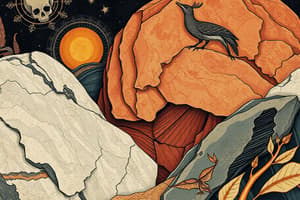Podcast
Questions and Answers
Which type of rock is formed when sediments are compressed and cemented together?
Which type of rock is formed when sediments are compressed and cemented together?
- Metamorphic rock
- Sedimentary rock (correct)
- Igneous rock
- Volcanic rock
What happens to sedimentary rocks when they experience intense heat and pressure?
What happens to sedimentary rocks when they experience intense heat and pressure?
- They turn into metamorphic rocks (correct)
- They disintegrate completely
- They remain unchanged
- They melt into magma
Where are fossils commonly found?
Where are fossils commonly found?
- In metamorphic rocks
- In igneous rocks
- In the outer core
- In sedimentary rocks (correct)
Which layer of the Earth is primarily composed of liquid iron and nickel?
Which layer of the Earth is primarily composed of liquid iron and nickel?
How are landforms primarily shaped according to the text?
How are landforms primarily shaped according to the text?
What are the three main categories in which rocks are classified based on their mode of formation?
What are the three main categories in which rocks are classified based on their mode of formation?
Which type of rocks are formed when molten magma or lava cools and solidifies?
Which type of rocks are formed when molten magma or lava cools and solidifies?
What type of rocks are made up of fragments of other rocks or minerals that have been transported and deposited in layers?
What type of rocks are made up of fragments of other rocks or minerals that have been transported and deposited in layers?
Which process describes the continuous transformation of rocks from one type into another?
Which process describes the continuous transformation of rocks from one type into another?
Which geological force or event is responsible for the formation of metamorphic rocks?
Which geological force or event is responsible for the formation of metamorphic rocks?
Flashcards are hidden until you start studying
Study Notes
Geology: Understanding the Earth's Composition and Processes
Geology is the study of the solid Earth, of the rocks, minerals, and physical processes associated with the Earth's physical structure and substance. This field of science encompasses a wide range of topics, from the formation and classification of rocks to the processes that shape our planet over billions of years. In this article, we will explore several key subtopics within geology: types of rocks, the rock cycle, fossils, earth's layers, and landforms.
Types of Rocks
Rocks are classified into three main categories based on their mode of formation: igneous, sedimentary, and metamorphic.
-
Igneous rocks are formed when molten magma or lava cools and solidifies. They can be further divided into two groups: intrusive (crystallizing slowly beneath the surface) and extrusive (forming quickly at the surface).
-
Sedimentary rocks are made up of fragments of other rocks or minerals that have been transported by water, wind, ice, or gravity and then deposited in layers. Examples include sandstone, limestone, shale, and coal.
-
Metamorphic rocks are formed when existing rocks undergo changes due to heat, pressure, or chemical reactions. Common examples include marble (formed from limestone), slate, gneiss, and schist.
The Rock Cycle
The rock cycle describes the continuous process by which rocks are transformed from one type into another through various geological forces and events. Over time, as rocks are exposed to different conditions, they can change form. For instance, sediments may be compressed and cemented together to create sedimentary rocks; these rocks might later experience intense heat and pressure, resulting in metamorphic rocks; eventually, some portions of these rocks may melt and form new magma, which cools to create igneous rocks. This cyclical process helps explain the Earth's internal dynamics and its evolving surface features.
Fossils
Fossils are the preserved remains or traces of prehistoric organisms, including plants and animals. They provide valuable clues about the Earth's biosphere over millions of years. Fossils can be found in sedimentary rocks, often formed when organisms die and become buried by sediment, such as sand or volcanic ash. Over time, the sediment hardens into rock, preserving the remains or impressions of the organisms. Fossils can help researchers understand extinct species and their evolutionary relationships, as well as the history of life on Earth.
Earth's Layers
The Earth consists of several layers, each with distinct properties and characteristics. From outermost to innermost, these layers include the crust, mantle, outer core, and inner core.
- The crust is the Earth's outermost layer, where we live. It ranges in thickness from about 5 km under the oceans to over 70 km beneath the continents.
- Just below the crust lies the mantle, a thick layer composed primarily of silicates and iron. The mantle is divided into the upper mantle (asthenosphere) and lower mantle. The upper mantle is semifluid and drives the movement of tectonic plates, while the lower mantle is more solid.
- The outer core is an outermost part of the mantle, located beneath the lower mantle. It is mostly composed of liquid iron and nickel, and it generates the Earth's magnetic field.
- The Earth's inner core is the central part of the planet, consisting mainly of solid iron and nickel. It is under extreme pressure and temperature conditions, and it is believed to be the hottest part of the Earth.
Landforms
Landforms are the physical features that make up the Earth's surface, including mountains, valleys, plateaus, and plains. They are formed through various geological processes, such as tectonic plate movements, erosion, and weathering. Some familiar landforms include the Himalayas, the Amazon River Basin, and the Sahara Desert.
In conclusion, geology is a broad and fascinating field of study that encompasses the Earth's rocks, minerals, and processes. By exploring topics like rock types, the rock cycle, fossils, earth's layers, and landforms, we gain a deeper understanding of our planet and its rich history.
Studying That Suits You
Use AI to generate personalized quizzes and flashcards to suit your learning preferences.




